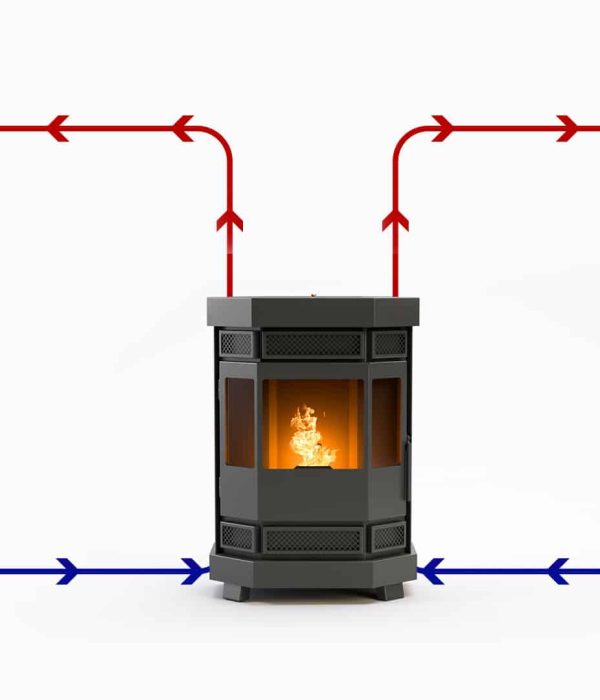Efficiency and power
Modern technology
Efficiency, the honest story
Duroflame pellet stoves are developed in-house in the Netherlands. We work with inspection body SGS, which is a worldwide ‘Notified Body’ in the field of certification of pellet stoves, among other things. The efficiency and all other values are determined in the tests carried out during certification by this independent organisation, which is also monitored by the government.
The efficiencies of Duroflame products range from 85 to 95%.

In practice, you can simply say that of the 100% energy in the fuel, about 85-95% stays in the house and the rest disappears through the chimney. Of course, this is not the same for every fuel and every moment in the combustion process or power applied.
The big advantage of pellets is that the calorific values are fairly constant and so is the moisture content. In addition, the human influence on the combustion process is very small.
Using pellets as fuel is the cleanest way to use biomass as a heating fuel partly because of the above reasons.
Are pellet stoves efficient?
Efficiency can be explained in terms of both the ability to extract heat from fuel and transfer heat to a room.
Pellet stoves tend to be one of the more efficient forms of solid fuel combustion. Pellet stoves have a number of advantages over other types of wood-burning equipment and all of these can come together to create an efficient burning experience where the most heat can be produced from each piece of fuel.
It is worth noting that unlike many other types of stoves, pellet stoves are electric appliances. Pellet stoves are designed to make the process of burning solid fuel to produce heat for a home more automated and efficient.
These electronic components work together thanks to a central control unit that regulates all processes to provide the cleanest possible combustion. Pellet stoves do need to be connected to the home’s electricity supply because of this.
Efficiency and output can be considered in terms of:
- How well a device extracts heat from the fuel.
- How well a device transfers the heat generated into usable heat for the room.
Pellet stoves take both elements into account and use the range of electronic components and sensors to help them be one of the more efficient forms of solid fuel burning appliances.
The ways in which pellet stoves help generate heat from fuel for efficiency include:
- Burning fuel in the form of pellets, which are made of wood which is compressed for greater energy output.
- Keeping the fuel in the stove using a hopper so that manual loading is not necessary.
- Controlling the rate at which pellets are fed from the hopper to the fire in the combustion chamber to maximise fuel efficiency for heat output.
- The use of a flue fan to control airflow through the stove, including how much fresh air is fed to the fire.
- The series of sensors tell the central control unit what needs to be adjusted for the most efficient combustion.
Maximising returns
Using good quality pellets helps a pellet stove maximise efficiency in terms of getting the most heat with minimal waste and emissions. Using poor quality pellets can reduce the efficiency of a pellet stove and void a stove’s warranty.
The fire in a pellet stove is kept in a sealed combustion chamber for efficiency purposes. This allows the airflow from a pellet stove to be controlled for optimum combustion efficiency. Too little airflow and the fire may struggle to produce heat, increasing wastage.
Unlike traditional wood-burning stoves where the firewood has to be added to the fire manually, pellet stoves store the fuel in the pellet tank, inside the stove and automatically feed the fuel to the fire when needed. This helps ensure that only the right amount of fuel is burned at any given time for increased heat output and efficiency.
Pellet stoves therefore have a number of features to work as efficiently as possible, but extracting as much heat as possible from solid fuel pellets is only part of the process to maximise efficiency. This is because pellet stoves also need to efficiently transfer the heat generated from the sealed combustion chamber into the room.
Pellet stoves are able to distribute heat efficiently to the room by:
- A room fan distributing warm air via convection.
- Channelling the air around the outside of the combustion chamber, allowing the air to heat up along the way.
- Releasing heat from the combustion chamber to the moving air more efficiently by using heat sink core.
- Discharging radiant heat through the front of the stove around the combustion chamber.
What are the savings of a pellet stove?
It may sound crazy, but firing wood pellets is more economical than heating your home with gas coming directly from the gas pipe into your central heating boiler. Do the maths?
Saving more than 50% compared to natural gas
A m3 of natural gas costs around € 3.831 and contains as much energy as 1.7 kg of pellets2. However, a kilo of ENplus A1 pellets costs an average of €1.103, so 1.7 kilo of pellets costs €1.87. Your stove achieves an efficiency of about 95%4, conveniently forgetting the efficiency loss on your central heating boiler.
For the same amount of energy, you then already pay 52% less!
Additional savings through pellet stove features
In addition, a pellet stove has the advantage that you heat locally; you do not need to fill an entire central heating system with hot water, but only generate heat where you need it. Ideally, you therefore turn your central heating down a degree and heat up with your pellet stove when you need it. A pellet stove is especially suitable in combination with underfloor heating, as these systems react rather slowly and a pellet stove reacts very quickly.
Then you are both green and economical!
Power, how does it work? And how many kW of pellet stove do I need?
When buying a pellet stove, the maximum and rated power is often assumed. But more important is the minimum output of the pellet stove. The minimum output (kW) is given when the pellet stove is in fan position 1. In the case of a pellet stove with overcapacity, even at the lowest setting it will still firmly raise the temperature. In fact, a pellet stove runs most hours in this economy mode and that’s when you want the temperature to remain roughly the same. So by choosing a pellet stove with the right capacity, you will have an economical and powerful heating source in your home.
Often people tend to choose a pellet stove with too much power, the ‘better too much than too little’ logic. This is the wrong thinking. When choosing a pellet stove, it is important to choose the right power output as carefully as possible. One of the main disadvantages of too much power is simply that it gets way too hot. You should also bear in mind that the room where the pellet stove will be installed will be warmer than other rooms. Even if you have placed the pellet stove centrally, it will be warmer closer to the pellet stove than further away.
If you are planning to buy a pellet stove, it is very important to look carefully at the power the pellet stove delivers. This is for the following reasons:
- The stove will consume more pellets due to greater output
- The stove will use more electricity
- The room heats up too quickly
- The stove is off more than on
How much power can Duroflame pellet stoves deliver?
Minimum power even more important?
What is perhaps even more important is the minimum power rating of the pellet stove. This is the power the stove gives off when it burns at the lowest setting. This will usually be around 2.5 kW. In general, a pellet stove will usually burn at the lowest setting, it is important then that the stove can keep the temperature constant.
Small pellet stove with an output of 5 kW:
The Rembrand, Abel (Large) and Carré also fall into the 5 kW pellet stove category. Perfect for smaller rooms. These stoves are also perfect if you are looking for a 4 kW pellet stove. The advantage of these smaller pellet stoves is that they operate at a low power level, which means the stoves can burn at a higher setting more often.
- Abel 5 kW
- Rembrand 6.1 kW
- Carré 6.1 kW
- Jurre 5 kW
Pellet stoves between 5 and 7 kW
In the 5 to 7 kW heater category, we have 4 models in our range. Ideal for providing average living rooms with a fine climate.
- Rembrand 6.1 kW
- Carré 6.1 kW
- Rinus 7.3 kW
- Pelle 7.3 kW
Pellet stoves between 5 and 7 kW
Our Batavia offers the highest maximum power. A stove with a lot of power to heat large spaces. A pellet stove that has a little more power than necessary can quickly create a pleasant climate in the house. Our 8 kW is also ideal for when you are looking for a 6 kw heater.
- Batavia 7.6 kW
- Rinus 7.3 kW
- Pelle 7.3 kW

